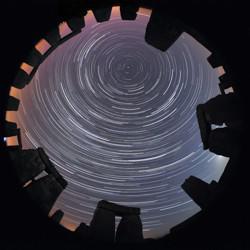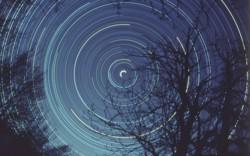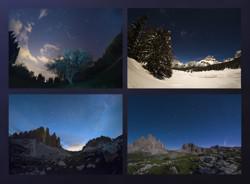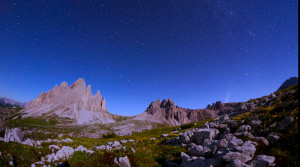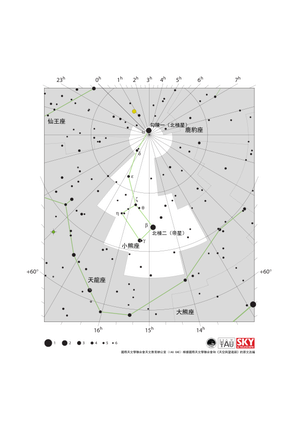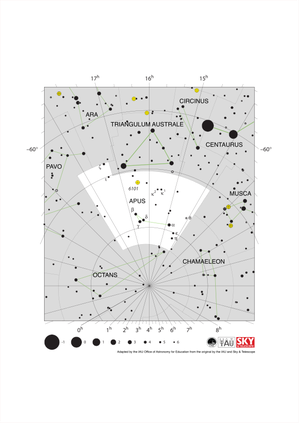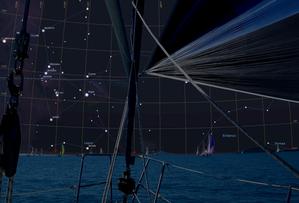Glossary term: 拱極星
Description: 在地球上的大多數地方,都能在地平線以上一定距離的天空中看到北天極或南天極。對於處於這樣一個位置的觀測者來說,隨著時間的流逝,星星似乎在圍繞著天極旋轉:每顆恆星都在天空中劃出一個圓圈,其中心是地軸指向的天極。在圓圈與觀測者地平線相交的兩點,即東點和西點,該恆星將分別升起和落下。對於距離天極足夠近的恆星,其劃出的圓圈將完全位於地平線之上。我們的觀測者將永遠看不到這些恆星升起或落下。這些永不落下的恆星被稱為拱極星。
哪些恆星是拱極星取決於觀測者的地理緯度和恆星的赤緯——後者是恆星所在位置與天赤道之間的夾角。在北半球,如果一顆恆星的赤緯大於90°減去觀測者的地理緯度,那麼它就是拱極星。在南半球,我們需要考慮到地理南緯和恆星的南赤緯都帶有負號。考慮到這些負號,在南半球,如果一顆恆星的赤緯小於-90°減去觀測者的地理緯度,那麼它就是拱極星。
Related Terms:
See this term in other languages
Term and definition status: The original definition of this term in English have been approved by a research astronomer and a teacher The translation of this term and its definition is still awaiting approval
This is an automated transliteration of the simplified Chinese translation of this term
The OAE Multilingual Glossary is a project of the IAU Office of Astronomy for Education (OAE) in collaboration with the IAU Office of Astronomy Outreach (OAO). The terms and definitions were chosen, written and reviewed by a collective effort from the OAE, the OAE Centers and Nodes, the OAE National Astronomy Education Coordinators (NAECs) and other volunteers. You can find a full list of credits here. All glossary terms and their definitions are released under a Creative Commons CC BY-4.0 license and should be credited to "IAU OAE".
If you notice a factual or translation error in this glossary term or definition then please get in touch.
Related Media
石陣與星環,巨石陣上方的星軌,作者:Till Credner,德國
Credit: Till Credner/IAU OAE
License: CC-BY-4.0 Creative Commons 姓名標示 4.0 國際 (CC BY 4.0) icons
半日北極星曝光圖,作者:來自意大利的法布里齊奧-梅蘭德里
Credit: 法布里齊奧-梅蘭德里/國際天文學聯合會教育辦公室
License: CC-BY-4.0 Creative Commons 姓名標示 4.0 國際 (CC BY 4.0) icons
如咪如幻的星空和氣流
Credit: Likai Lin/IAU OAU
License: CC-BY-4.0 Creative Commons 姓名標示 4.0 國際 (CC BY 4.0) icons
四季的北斗
Credit: Giorgia Hofer/IAU OAE
License: CC-BY-4.0 Creative Commons 姓名標示 4.0 國際 (CC BY 4.0) icons
北斗七星和新智彗星 C2020 F3
Credit: 喬爾賈·霍弗/國際天文學聯合會教育辦公室 (CC BY 4.0)
License: CC-BY-4.0 Creative Commons 姓名標示 4.0 國際 (CC BY 4.0) icons
Related Diagrams
Cassiopeia Constellation Map
Credit: Adapted by the IAU Office of Astronomy for Education from the original by IAU/Sky & Telescope
License: CC-BY-4.0 Creative Commons 姓名標示 4.0 國際 (CC BY 4.0) icons
小熊座星圖
Credit: 國際天文學聯合會天文教育辦公室(IAU OAE)根據國際天文學聯合會和《天空與望遠鏡》的原文改編
License: CC-BY-4.0 Creative Commons 姓名標示 4.0 國際 (CC BY 4.0) icons
大熊座星圖
Credit: 國際天文學聯合會天文教育辦公室(IAU OAE)根據國際天文學聯合會和《天空與望遠鏡》的原文改編
License: CC-BY-4.0 Creative Commons 姓名標示 4.0 國際 (CC BY 4.0) icons
Apus Constellation Map
Credit: Adapted by the IAU Office of Astronomy for Education from the original by IAU/Sky & Telescope
License: CC-BY-4.0 Creative Commons 姓名標示 4.0 國際 (CC BY 4.0) icons
Auriga Constellation Map
Credit: Adapted by the IAU Office of Astronomy for Education from the original by the IAU and Sky & Telescope
License: CC-BY-4.0 Creative Commons 姓名標示 4.0 國際 (CC BY 4.0) icons
Related Activities
Navigation in the Ancient Mediterranean and Beyond
astroEDU educational activity (links to astroEDU website) Description: Learn the ancient skill of Celestial Navigation
License: CC-BY-4.0 Creative Commons 姓名標示 4.0 國際 (CC BY 4.0) icons
Tags:
History
, Geography
, Celestial navigation
Age Ranges:
14-16
, 16-19
Education Level:
Middle School
, Secondary
Areas of Learning:
Discussion Groups
, Modelling
, Social Research
Costs:
Low Cost
Duration:
1 hour 30 mins
Group Size:
Group
Skills:
Analysing and interpreting data
, Asking questions
, Communicating information
, Developing and using models
, Planning and carrying out investigations
, Using mathematics and computational thinking
